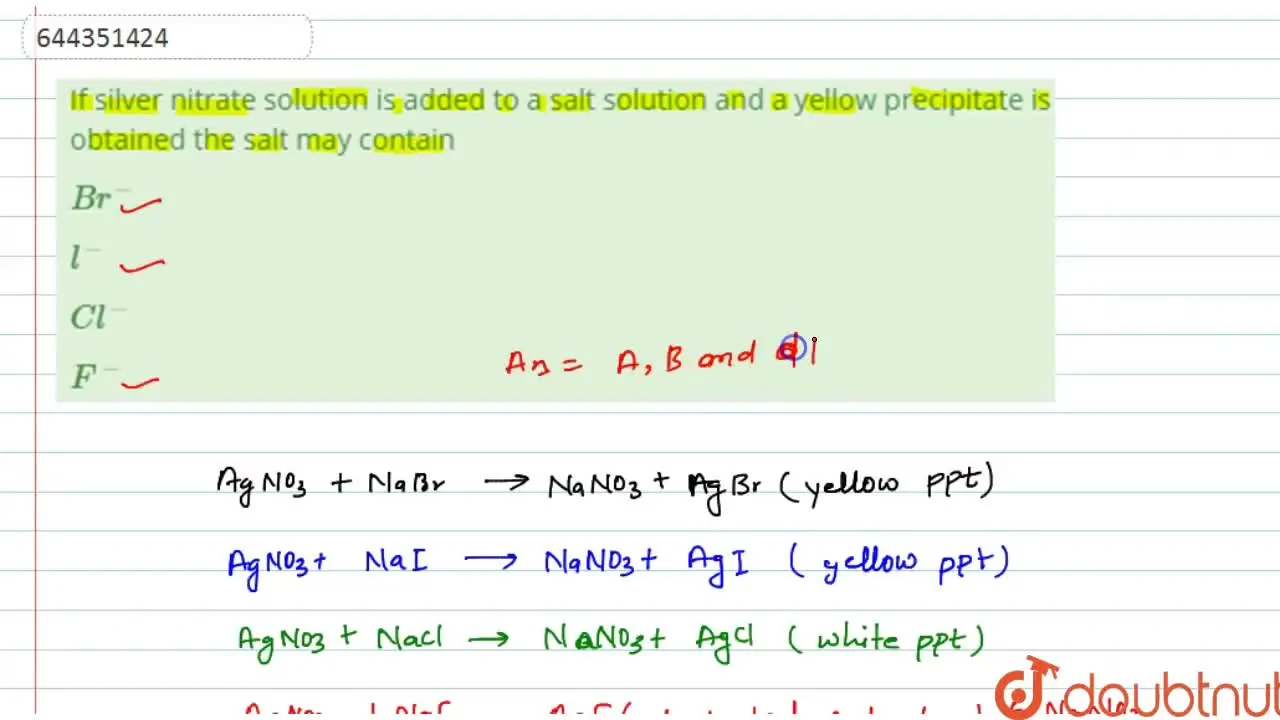If silver nitrate solution is added to a salt solution and a yellow precipitate is obtained the salt may contain
Br−
l−
Cl−
F−
The correct Answer is:A, B
Step by step video & image solution for If silver nitrate solution is added to a salt solution and a yellow precipitate is obtained the salt may contain by Chemistry experts to help you in doubts & scoring excellent marks in Class 12 exams.
Related Playlists
- BOOK - AAKASH INSTITUTE ENGLISHCHAPTER - PRINCIPLES OF QUALITATIVE ANALYSISEXERCISE - Assignment (SECTION C)12videos
PRINCIPLES OF QUALITATIVE ANALYSIS
- BOOK - AAKASH INSTITUTE ENGLISHCHAPTER - PRINCIPLES OF QUALITATIVE ANALYSISEXERCISE - Assignment (SECTION D)9videos
PRINCIPLES OF QUALITATIVE ANALYSIS
- BOOK - AAKASH INSTITUTE ENGLISHCHAPTER - PRINCIPLES OF QUALITATIVE ANALYSISEXERCISE - Assignment (SECTION A)25videos
PRINCIPLES OF QUALITATIVE ANALYSIS
- BOOK - AAKASH INSTITUTE ENGLISHCHAPTER - POLYMERSEXERCISE - ASSIGNMENT (SECTION-D)13videos
POLYMERS
- BOOK - AAKASH INSTITUTE ENGLISHCHAPTER - REDOX REACTIONSEXERCISE - ASSIGNMENT SECTION - D10videos
REDOX REACTIONS
Similar Questions
Silver nitrate solution is used to study
View SolutionA white sodium salt dissolves in water to give a solution which is neutral to litmus.When silver nitrate solution is added to the solution, a white precipitate is obtained which does not dissolve in dilute HNO3.The anion is
View SolutionIdentify the anion present in each of the following compounds :
When barium chloride solution is added to salt solution E a white precipitate insoluble in dilute hydrochloric acid is obtainedView SolutionA salt bridge may contain:
View SolutionA white precipitate is formed when silver nitrate is added to a solution containing chloride ions. This precipitate is soluble in
Hydrochloric acid ; Nitric acid ; Dilute H 2 S O 4 ; Ammonium hydroxide ;View SolutionSilver nitrate on reaction with sodium iodide gives yellow precipitate of
View SolutionA crystalline solid dissolves in walur lo give colourless solution. On addition of aqueous silver nitrate, a yellow precipitate is formed. The solid is most likely to be
View SolutionIdentify the anion present in the following compound : When a solution of compound Y is treated with silver nitrate solution a white precipitate is obtained which is soluble in excess of ammonium hydroxide solution.
View SolutionSalt (A) is a white deliquescent solid. On heating the solid, brown fumes were evolved. On adding NaOH to the salt solution of (A), a white gelatinous ppt. was obtained. On adding, a drop of blue litmus solution to the ppt., a blue lake was obtained. On adding DPA to the salt solution, a deep blue colouration was obtained. Identify the salt and give the equations involved.
View SolutionSolutions of silver nitrate and sodium chloride react to form a white precipitate of
View Solution


